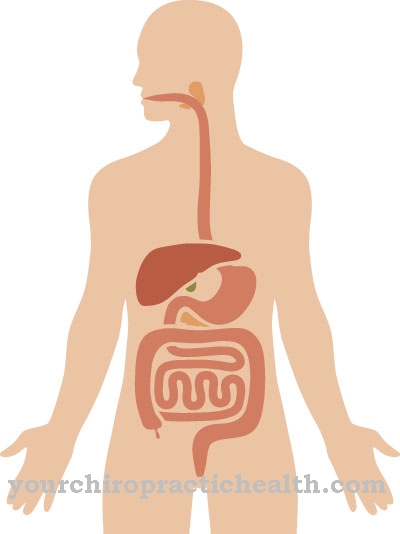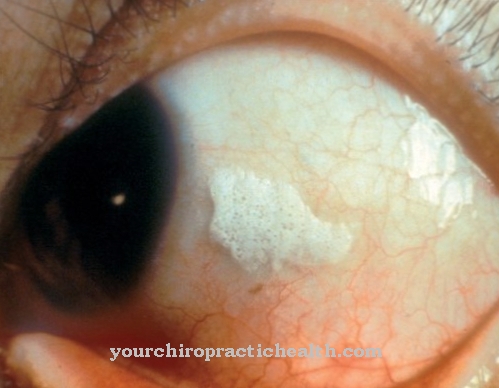In medicine one designates with a so-called Sinus vein thrombosis, or short Sinus thrombosis, a thrombotic occlusion of a cerebral sinus. Sinus vein thrombosis usually affects women.
What is Sinus Vein Thrombosis?

© SciePro - stock.adobe.com
As part of a Sinus vein thrombosis blood clots collect in the veins of the brain. However, clinical symptoms do not always result from an occlusion of the large collecting veins. In principle, the venous system in the brain has a particularly high degree of flexibility.
However, sinus vein thrombosis often leads to a so-called rush of blood. In the course of venous congestion, the blood increasingly collects in the area of the brain. If the blood volume is not regulated, the affected person may suffer a stroke.
causes
The causes of a Sinus vein thrombosis are relatively diverse. Infectious causes are primarily responsible for the occurrence of a sinus vein thrombosis. The occurrence of a sinus vein thrombosis is particularly often promoted by the so-called staphylococci.
As a result of an infection in the face, the poison of the bacterium can spread unhindered. Sinus vein thrombosis often appears as a late sequela of so-called sinusitis. Inflammation of the sinuses is considered to be one of the most common causes of sinus vein thrombosis.
In addition to the infectious causes, however, the generalized causes in particular are responsible for the occurrence of a sinus vein thrombosis. The occurrence of a thrombotic occlusion in the area of the brain is promoted by measles disease, among other things.
Symptoms, ailments & signs
To this day, medical professionals have found it difficult to clearly diagnose sinus vein thrombosis. This is because many of the initial symptoms suggest other conditions. Basically, a distinction is made between non-inflammatory and inflammatory sinus vein thrombosis.
If there is a high fever, this indicates an inflammatory expression. The signs worsen over time. Finally, death can occur as a result of a stroke. At first, severe headaches burden everyday life for several days. What those affected usually interpret as a migraine turns out to be a sinus vein thrombosis in combination with other symptoms.
Visual disturbances and unusual pain in the nose and eye area also occur. After this first phase, the signs change. Pain in the entire head and neck area is now possible. Seizures and epileptic deficits arise. Patients vomit or feel nauseous. In addition, psychological effects are now becoming apparent.
People close to you and acquaintances perceive disturbances of consciousness and changes in personality. Sinus vein thrombosis reaches its temporary climax when paralysis occurs. The eyesight is so weakened that it comes to a standstill. If further treatment is excluded, intracranial pressure develops in the head. Death occurs if those affected do not seek medical help immediately.
Diagnosis & course
A Sinus vein thrombosis is relatively difficult to diagnose despite medical advances. Often times, the symptoms point to another disease during an initial examination.
The determination of the so-called D-dimer level in the blood can never fully confirm an initial suspicion of a sinus vein thrombosis. For this reason, so-called sectional image diagnostics is used as an imaging method. So-called infarct zones and bleeding can be clearly detected in both computed tomography and magnetic resonance imaging. Often, however, the administration of a so-called contrast agent is essential to better visualize the individual areas.
Sinus vein thrombosis, however, cannot be diagnosed using just the individual imaging tests. So-called laboratory diagnostics are often used as an alternative method. Medical detection of the so-called C-reactive protein is enjoying increasing popularity.
This form of protein is a special plasma protein that is produced in the liver. Often the C-reactive protein is a clear indication of a sinus vein thrombosis. In the context of laboratory diagnostics, however, the so-called sedimentation rate is also often determined.
Complications
In the worst case, sinus vein thrombosis can result in death of the patient. However, death can be avoided by observing the warning signs of thrombosis and thus avoiding further complications. The patients primarily suffer from very severe pain in the neck and head area.
This pain often spreads to other regions of the body. The patient may also experience cramps or an epileptic seizure. Those affected also suffer from paralysis, but this only occurs temporarily and disappears again after a short time. Visual disturbances or disturbances of consciousness can also become noticeable as unpleasant side effects of sinus vein thrombosis and have a very negative effect on the patient's quality of life.
If the person loses consciousness, they may also be injured if they fall. In addition, the disease often leads to fever and thus to general tiredness and fatigue. Treatment of sinus vein thrombosis is carried out with the help of drugs.
There are no complications. However, those affected with this disease need regular examinations to avoid further complications. Whether this will result in a reduced life expectancy cannot generally be predicted.
When should you go to the doctor?
Sinus vein thrombosis always requires medical treatment. In the worst case scenario, this disease can lead to death if the disease is not treated in time.This can also lead to significant complaints in the everyday life of the patient, so that the sinus vein thrombosis should be treated at the first signs. A doctor should be consulted for this disease if the person concerned has a severe fever. This leads to various heart problems, with those affected mostly being tired and unable to concentrate.
Visual disturbances or various cramps can also indicate sinus vein thrombosis and should be examined by a doctor if they occur for no particular reason and do not go away on their own. Furthermore, a strong nausea or severe disturbance of consciousness can indicate the sinus vein thrombosis. If these symptoms occur, a doctor must be consulted immediately. Usually the disease is treated by a cardiologist. In emergencies or in the event of very severe complaints, an emergency doctor should be called or the hospital should be visited.
Treatment & Therapy
Unless a Sinus vein thrombosis has been diagnosed, immediate therapy is essential to avoid possible long-term effects. As part of the therapy, the affected person is given the agent heparin. The intravenous administration of heparin is intended to prevent the effects of individual coagulation factors in the blood. Until the so-called thromboplastin time has doubled, those affected have to be treated with heparin. The thromboplastin time is a special laboratory value that provides information about blood clotting. If the blood coagulation meets the set requirements, oral administration of anticoagulants over a period of around 6 months is considered.
Since sinus vein thrombosis is often associated with epileptic seizures, another drug is administered in addition to the anticoagulants. The administration of phenytoin is intended to minimize the risk of epileptic fits. In the context of reliable therapy, however, not only the treatment of sinus vein thrombosis is in the foreground. The cause of a thrombotic occlusion in the brain area should always be treated. If the sinus vein thrombosis is due to an infection, those affected must take a fast-acting antibiotic.
prevention
Complete recovery can be achieved in approximately 85 percent of all cases. Despite medical advances, one can Sinus vein thrombosis cannot be actively prevented. However, if clinical symptoms arise, a doctor should be consulted immediately. This is the only way to prevent possible late effects.
Aftercare
In the further course of treatment with anticoagulants (drugs to inhibit blood clotting - for example heparin or Marcumar), around 57 percent of people suffering from sinus vein thrombosis (SVT) are symptom-free after 6 months. This is proven by a study of the “International workshop on Cerebral Venous Thrombosis”. In the group of people who are reported to be symptom-free, follow-up care aims to prevent a new SVT. This may require drug treatment with a vitamin K antagonist for three to twelve months.
In addition, it is medically recommended to carry out an annual screening for coagulation disorders. In addition, epilepsy occurs in ten percent of diseases over the long term. Epilepsy can be treated with medication for life. Electroencephalography (EEG) should be performed regularly (at least once a year) during follow-up. In addition, the drug level must be determined by taking a blood sample.
Stopping the medication can tell whether the epilepsy persists. The acute mortality rate with SVT is about eight percent. In the event of the sick person's death, the subject of aftercare is survivor therapy with a focus on coping with grief. SVT manifests itself permanently in around four percent of sick people.
The use of blood clotting medication is provided as a long-term treatment. In addition to the annual screening for coagulation disorders, an annual imaging examination (computed tomography or magnetic resonance tomography) is recommended as a follow-up examination.
You can do that yourself
In everyday life it is important to ensure that the blood circulation is not impaired by external influences or by adopting an unhealthy posture. Regular balancing movements and the avoidance of rigid postures are particularly important. A congestion of the blood should be avoided at all costs.
If long distances are covered, it must be ensured that there is sufficient freedom of movement. Wearing thrombosis stockings and items of clothing that do not interfere with blood flow in any way are highly recommended in everyday life. In particular, wearing tight belts or other objects that constrict parts of the body should be avoided. Overall, they do not have a good influence on the organism. Sports activities support the blood circulation in its activity. Often it is sufficient to carry out small movements of individual body parts during the course of the day to stimulate the blood circulation. As soon as sensory disturbances occur or a tingling sensation is noticed on the skin, the posture should be changed and light exercises should be performed.
In addition, the blood system can be positively supported through a targeted intake of certain foods. The production of blood is stimulated with foods like pomegranates, nuts or legumes. In addition, foods containing caffeine or hot spices can increase blood pressure. Therefore, those affected can contribute to improving their health in everyday life through their diet.

.jpg)











.jpg)

.jpg)
.jpg)











.jpg)